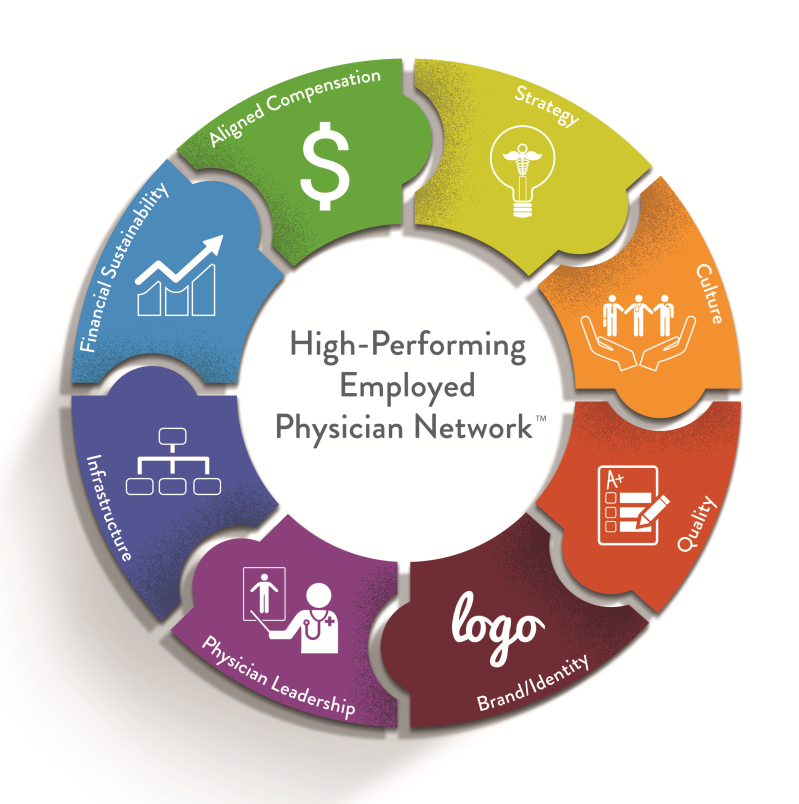Effectively building a high-performing employed physician network takes time and focus. Most networks are fraught with problems at every level and lack sufficient resources to ensure the production of value needed. The most common problems we see with employed networks are:
- Lack of overall strategy and strategic action plans;
- Weak group culture;
- Limited focus on and an inability to measure quality;
- Lack of an established brand or separate marketing plan;
- Low physician engagement and lack of physician leadership;
- Lack of standardization in both practice operations and the way in which information is shared;
- Poor revenue cycle performance and mounting financial losses; and
- Compensation plans that are poorly structured and improperly aligned with the hospital’s goals.
Undoing the knots is difficult and requires systematic attention. We have identified eight key areas that every employed physician group must excel at in order to achieve a high-performance status. These eight key areas are depicted in the graphic below.

Assessing how you stack up against the eight key areas requires asking the right questions.
Based on HSG’s many years of working with physician networks, we have developed an assessment process based on asking the right questions. We use this process to identify deficits and to help our clients think through these questions as, together, we create a roadmap for future success.
Following is a discussion of each of the eight key areas and best practices to building a high-performing employed physician network:
Strategy
Strategy is the foundation and cornerstone for an effective employed physician network. Strategy defines vision and purpose, which produces objectives and action plans to create a path forward. Though closely linked, employed physician group strategy is separate and distinct from hospital strategy. The ultimate goal is to develop a concise strategy for the next 18 to 36 months with four to five key objectives. Too many objectives can limit your ability to effectively manage them and will cause you to lose focus.
The plan should identify both short- and long-term objectives and ways by which to measure implementation. The planning process should involve input from both physician and non-physician leadership. The role your physicians and practices play in the marketplace and how you position them is important. Identifying the proper mix of primary care and specialty physicians impacts your ability to provide care to patients. Maximizing your ability to capture volume in the marketplace is a fundamental component to leveraging better rates with payers.
Culture
Culture is a great buzzword, but, practically speaking, it’s hard to understand because it’s complex. Most employed physician groups are comprised of physicians with different personalities, backgrounds, and philosophies about how to practice medicine and manage people. However, culture is the mortar that holds the building blocks of the employed physician group together.
The problem is that you have taken physicians from disparate groups and placed them altogether with little thought as to how they should interact. To be successful, your employed physician group must be coalesced around a common vision and culture, which encourages teamwork and collaboration. Establishing a separate physician advisory council is an effective way to begin the process. Discussing with physicians the type of culture you want to have and defining behavioral norms is essential.
Quality
Identifying quality metrics and implementing a process by which to measure them and address gaps leads to improved patient care. And encouraging physicians to refer within the employed physician network and providing for the timely sharing of information enhances the coordination of patient care.
Ultimately, creating a network built on quality is the lynchpin under value-based reimbursement. You must have quality metrics that can prove to payers that you can produce results. At a minimum, you need to define customer service standards and expectations. Communicating quality initiatives and performance to physicians and physician extenders across the network is key.
Financial Sustainability
Financial sustainability represents the heart of the issue for most employed physician networks. Sustainable networks perform disciplined internal assessments on a regular basis to identify opportunities for operational and financial improvement. To manage the financial aspects of the network, develop a dashboard that measures key performance indicators, such as days in AR, net loss per physician, charge capture, gross and net collections percent, and number of new patients, to name a few. A dashboard will help you measure your network’s performance against national benchmarks and best practices.
Effective networks have a strong revenue cycle and hold physicians accountable if cost savings or initiatives are not achieved. Sustainable networks also have a direct positive contribution margin for each practice and physician. Additionally, controlling a sufficient amount of the market for PCPs and leveraging care management capabilities will help you drive better rates with payers.
Aligned Compensation
Physician compensation is one of the biggest contributors to practice losses and one of the most cumbersome areas to manage. Compensation plans for physicians must be competitive, but should also reward results and reinforce behaviors that help the group and organization achieve its objectives and implement its strategies. To achieve acceptable margins, total physician compensation must be limited as a percent of patient revenue and aligned across the organization.
Effective compensation plans:
- Tie total compensation to performance in terms of both productivity and quality;
- Allow base salary to be reduced if a physician does not meet minimum performance standards;
- Contain clear, measurable quality/outcome metrics that further the organization’s goals and objectives by rewarding physicians for improved performance;
- Are standardized across the network to make administration easier;
- Are in sync with the realities of today’s healthcare market and the shift from volume to value; and
- Promote a shared group culture.
Infrastructure
As employed physician networks have grown rapidly over the recent years, so has the need to expand infrastructure and assess the network’s capabilities. Infrastructure includes day-to-day functions, such as IT, operations management, HR, accounting and finance, revenue cycle, and purchasing, as well as the overall organizational structure. As the industry shifts to a fee-for-value environment, information technology must be designed to aggregate and analyze clinical data and deliver the right information at the right time, so that providers can deliver the highest quality care.
From a process perspective, operations should be standardized across the network. That means having similar HR policies and procedures and centralized accounting, billing, and purchasing functions. Another key component of infrastructure is assessing management’s ability to effectively operate large practice operations. If your management team is weak, you will not achieve the results you want from your network.
Physician Leadership
Identifying physician leaders — rather than accepting elected leaders with varying abilities — is becoming a core competency for employed physician networks. Organizations must develop and cultivate key physician leaders who understand clinical issues and are committed to improving quality. Just like hospital administrators, physician leaders must be incentivized to implement strategies and tactics that will make the group a success.
While not exclusively their purview, physician leaders must have major roles in defining clinical practices and ensuring those practices meet standards of care. Physician leaders must model and be the drivers of the corporate culture, including holding peers accountable who run afoul of accepted norms. Because physicians have the most intense interactions with patients, they can also provide unique insights into practice operations that must be incorporated into management decisions and policy. Leadership of large groups takes time, skill, and savvy, and physicians should be compensated rather than being asked to assume the role on a voluntary basis.
Brand/Identity
The brand of the network must align with, complement, and support the system or hospital brand. That said, it’s still necessary to have a separate and distinct marketing plan for the network, which addresses brand-building activities, promotional tactics, marketing infrastructure, and the resources required. The goal is to build a positive patient perception and experience.
Developing an effective brand requires hiring the right physicians, engaging the community through a liaison program, and delivering an effective marketing/communications campaign. Conducting routine patient satisfaction surveys is essential. The results of the surveys will help you measure the effectiveness of your brand and overall identity in the marketplace.
For more information on developing a high-performing physician network, HSG’s network/practice assessment product and management advisory services, contact Partner Neal Barker at (502) 814-1189 or nbarker@HSGadvisors.com.
